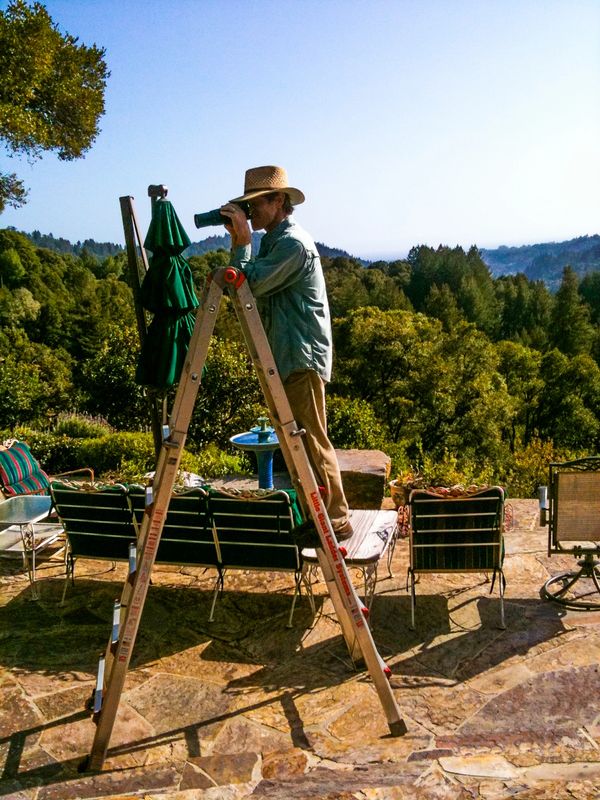About the Artist

I fell in love with photographing hummingbirds on April 12, 2011. I know this because my wife took a picture of me up on a ladder with my camera. Barbara came out to see what I was doing up on a ladder. I said, “honey, there are hummingbirds in this tree, and they are amazing!” My first pictures were pathetic, but I have improved my technique over the years.
The day before I shoot, I set up a hummingbird feeder where I plan to set up my ‘studio.’ I always begin my shoot by selecting a flower; often, it's a flower from the garden that the hummingbirds are used to feeding on; sometimes, I pick up a potted plant at the nursery; sometimes, I arrange a bouquet. I set up the flower next to the feeder. I set up three flashes around the flower. It takes some time to adjust the height and angle of the flower and the height and distance of each flash from the flower to get the illumination just right. I set up my camera on a tripod about twelve feet from the flower. I use patio umbrellas to keep the sun off the setup so that ambient light does not interfere with the flashes. When I'm finally ready to shoot, I use a syringe to spike the flowers with sugar water. Then I take the feeder away. When the hummingbirds return to where the feeder was, they usually fly off in a huff to find another feeder, but they are curious creatures, and sometimes they stick around to check out the flower. When they discover the 'nectar', they come back to it. During a shoot, I constantly refresh the sugar water and adjust the camera settings and position of the flashes and the flower.
I can shoot at any time of day or under any weather conditions. The best time is in the evening as it starts to get dark because this is when they tank up. My flashes have modeling lights to keep the flower illuminated when it would otherwise be too dark to focus.

The settings on the camera and the flashes are highly technical. I want the highest f-stop possible (f/22 is good) to get the greatest depth of field; I want the maximum amount of the flower and the bird to be in focus. I want a low ISO setting (100 – 200) for minimum noise. The shutter speed is low (250), and the flash duration is fast (at least 1/5000). Due to the inverse square law, the flashes must be very close to the subject – less than a foot.
I learned the basics of multiple flash photography from Ralph Paonessa on a hummingbird photography workshop tour to Ecuador in 2013. Most of the 300-plus species of hummingbirds live within 15 degrees of the equator. Since then, I have made two more trips to Ecuador with Ralph and three to Costa Rica, also with Ralph, to photograph hummingbirds. I’m planning to organize a hummingbird photography workshop here in Soquel for interested photographers. I will supply the flash equipment and the hummingbirds.
When I go through my pictures at the end of a shoot, it is always exciting to see what I have. Most of the pictures are discarded. So many things can go wrong – an eye is partly closed, the wings hide the head, the head is too far into the flower, too light, too dark, or perfect but boring. I keep about one out of a hundred shots, and some of those go into the calendar. For me, shooting hummingbirds is like panning for gold; most of it worthless, but occasionally there is something that glitters.
The shooting process is a lot of work; it is tiring and stressful. Action is fast. It demands my full attention to focus on each shot. The process of developing the pictures is rewarding and fun. I use Adobe Lightroom to edit my photos. I always shoot in the raw mode because this gives the most dynamic range, color, finer control, and adjustment potential. The pictures look plain until I adjust the color and lighting. Finally, I crop and center the picture. My 50-megapixel Canon 5DSR allows me to crop and still have enough pixels for a good print. The calendar requires square pictures. The camera has a rectangular aspect ratio, so some pictures can’t be cropped to a square format without losing part of the picture.
The hummingbirds don’t pose for free. I fill the garden with flowers that attract them. I have five feeders to keep cleaned and filled daily. When we go away, I hire a hummer sitter. I usually go through seven quarts of sugar water every day. I buy 50-100 pounds of sugar at a time. The hummingbirds know who the sugar daddy is.
This website uses cookies.
We use cookies to analyze website traffic and optimize your website experience. By accepting our use of cookies, your data will be aggregated with all other user data.